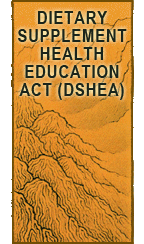Dietary Supplement Health Education Act Tutorial

In October 1994, the Dietary Supplement Health and Education Act (DSHEA) was signed into law by President William Jefferson Clinton. Before this time, dietary supplements were subject to the same regulatory requirements as were other foods. This new law, which amended the Federal Food, Drug, and Cosmetic Act, created a new regulatory framework for the safety and labeling of dietary supplements. [Source]
From DSHEA came a series of rules, and guidelines on how dietary supplements should design their labeling and any other publications in support of a given dietary supplement. Many TCM practitioners have begun to sell herbal products online. The vast majority of which rely on copying label conventions from each other.
If, as a TCM practitioner, you have enough money to spend on a team of lawyers to do all of this footwork for you, you’ll probably save yourself some time. If however, spending thousands of dollars is not an option, I encourage you to read on. Links to pertinent documents available through the FDA’s website are provided so you can get the information from the source.
The gancao.net DSHEA articles also show examples of how the guidelines would apply to a line of fictitious products produced by gancao.net as if it were a company selling herbal supplements. These visual guides can help self-employed TCM practitioners get up to code a little more quickly on their product labeling so we can continue to provide high quality products without provoking the ire of the U.S. Food and Drug Administration.
Much of the information presented here comes from the FDA’s document entitled Guidance for Industry, A Dietary Supplement Labeling Guide as well as Guidance for Industry – Structure/Function Claims, Small Entity Compliance Guide.
These guidelines are, in the words of the source texts “non-binding recommendations” which is to say that you can’t quote these documents in a court of law to support the way in which you may have tweaked, altered, spindled or mutilated the good advice found therein. And while we’re at it, don’t assume that anything you read here at gancao.net is going to stand up in a court of law. I do my best to provide accurate information but I have no license to practice law nor do I present myself as an expert in FDA regulations. I’m just a guy who did the footwork to market his own products in accordance to DSHEA guidelines.
I’ve been in the process of applying these guidelines to my own products and am happy to pass on what I’ve learned after months of sifting through hundreds of documents and website articles. Just thought that I’d save you some time.
There are two large topics addressed in this DSHEA feature.
- Product Labeling: This topic explains the physical structure of the product’s label. Where the disclaimer goes, whether or not you need to include “Supplement Facts” such as the amount of fat or vitamins included, where you can put your company’s modified yin/yang symbol, etc.
- Product Claims: These often show up on the label too. This is where we look at the legal assessment of the claims of the product. This is where we differentiate between “cures cancer” (an out of compliance claim) and “supports immune system functions” (much better). One thing that is very important to understand is in this context, “labeling” means any words in support of the product sales. That includes the product’s label, webpages where links to purchase opportunities exist (e.g. shopping carts or “buy now” buttons), and all the documents inserted into the box or shipping package that contains the actual product. These are all considered labels and labeling is where you’ll find claims.
Now, if you don’t make any claims on your labeling or your website or any other publications in support of sales of your product, you’re okay. You still have to get your product’s physical labeling right, but as for the claims, it’s not as big of a deal.
If you should find anything inaccurate on these DSHEA pages, or perhaps just something simple as a misspelling, please feel free to track me down and let me know.
-Al Stone, L.Ac., DAOM
Next: Let’s get going on designing our label.
 Last modified: September 1, 2009
Last modified: September 1, 2009  Tags: Claims, DSHEA, Labeling В· Posted in: DSHEA
Tags: Claims, DSHEA, Labeling В· Posted in: DSHEA
